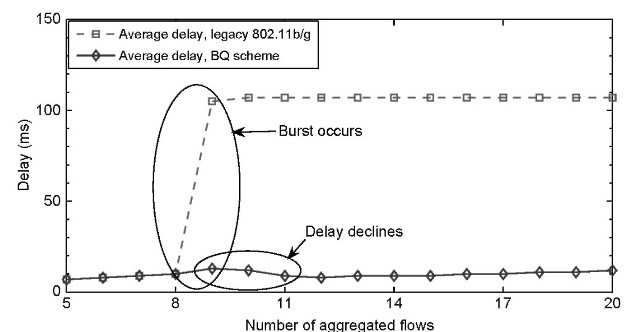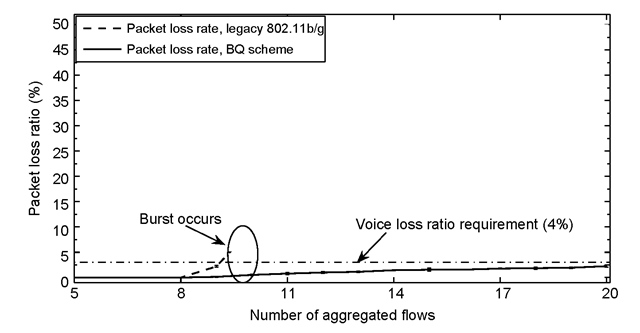13.5
13.5.1
Simulation Setup
We simulate the bottleneck nodes in Figure 13.1 and develop a test bed with nodes in a chain topology: each node is 200 m away and has a 250 m transmit range and a 550 m sensing range. To simulate the bottleneck condition, we send multiple aggregated flows from each end of the node; thus the middle node would become the bottleneck node. We use CBR traffic as our VoIP flow, the payload size is 33 bytes, the interval is 20 ms, and the data rate is 13.2 kbps as specified in the GSM. We run a TCP flow of the Reno version over the test model whose packet size is set to 1024 bytes. All simulations last 100 s in NS-2 [16].
13.5.2
BQ Over 802.11b/g
We first simulate the unidirectional condition. We transmit N aggregated VoIP flows from node A to node C (as shown in Figure 13.4).
As shown in Figure 13.5, when the number of flows is less than 5, broadcast does not happen, which means that the queues of three nodes never exceed 10. In these unsaturated networks, our scheme acts the same as legacy 802.11b/g protocol. Then we increase the number of the flows. When N reaches 8, the burst broadcast starts to occur under the BQ scheme as displayed in Figure 13.5. We can see that the average delay of BQ is much lower than that of legacy 802.11b/g. In addition, we observe that the average delay of legacy 802.11 b/g remains almost constant (106 ms) as shown in Figure 13.6 from 9 to 20 flows. The reason is that when the network is saturated, the packet transmission rate reaches its

FIGURE 13.4 Unidirectional VoIP flow over bottleneck model.

FIGURE 13.5 Packet delay of unidirectional VoIP flows over bottleneck model.

FIGURE 13.6 Packet loss ratio with 95% confidence interval of unidirectional VoIP flows over bottleneck model.
maximum capacity, and the extra packets are dropped due to the queue overflow. Thus, the average duration of each packet in the queue is the same. For BQ, we further observe that the average delay for 11 voice flows is even lower than that of 9-and 10-flows. This is because the busier the network, the more the BQ scheme takes place. For the 11-flow condition, the queue length of each node almost always exceeds the WATER_MARK, while for the 9- and 10-flow conditions, BQ does not occur as frequently. Moreover, the increasing trend of a short BQ delay for N > 12 comes from the packets leftover in the queue even after the broadcast.
Regarding the packet loss ratio, Figure 13.6 shows that when the number of flows is small (i.e., N < 9), there is no queue at the individual nodes. When the number of voice flows reaches 10, due to the queue overflow, legacy 802.11b/g yields a loss ratio of 9.9%, which exceeds the voice transmission requirement (4%). While in the BQ scheme, with 2043 times burst broadcast within the simulation period of 100 seconds, the queue in each node never overflows. The resulting 0.06% loss ratio due to the collision is much smaller than the voice transmission requirement (4%). We then increase N to 20, which is rather large, and see that with the queue overflow, legacy 802.11b/g suffers from a high packet loss rate, reaching up to 46.5%, while BQ maintains the loss ratio within the voice transmission requirement. Note that although BQ decreases the chances of queue overflow, if we keep increasing the number of flows, the packet loss ratio of BQ will also increase and the queue of our scheme will eventually overflow (e.g., 50 flows).
We now examine the simulation results for bidirectional flows. There are M voice flows transmitting two at a time from each end to the other end as shown in Figure 13.7, resulting in a total number of flows of 2 M.
Like the unidirectional condition, Table 13.2 shows the superiority of the BQ scheme as well. When M = 4, the network is unsaturated and no burst happens. When M reaches 5,

FIGURE 13.7 Bidirectional VoIP flow over bottleneck model.
TABLE 13.2
Loss Rate, Burst Broadcast Times Comparison
| M | 4 | 5 | 6 | 7 | |
| Legacy 802.11b | Loss rate (%) | 0 | 1.5 | 24.1 | 34.8 |
| BQ over 802.11b | Loss rate (%) | 0 | 0.1 | 0.06 | 3.0 |
| Burst times | 0 | 153 | 2615 | 4717 |
TABLE 13.3
Average Delay and Maximum Delay Comparison
| M | 5 | 6 | 7 | |
| Legacy 802.11b | Average delay (ms) | 96 | 268 | 275 |
| Maximum delay (ms) | 156 | 353 | 364 | |
| BQ over 802.11b | Average delay (ms) | 18 | 23 | 21 |
| Maximum delay (ms) | 71 | 92 | 92 |
bursts occur 156 times and BQ reduces the average delay by 81.3%. Legacy 802.11b/g could support only 5 pure voice pairs, and its delay is rather high, while BQ over 802.11b/g could support 7 pure voice pairs and still achieve a low average delay at 21 ms as shown in Table 13.3. The nodes A, B and C become the bottleneck when M reaches 6. The queue overflow results in the high loss ratio of 802.11b/g, and we also change the queue length to 500, but it becomes unhelpful and the delay exceeds 400 ms, which is apparently not acceptable. We note that the improvement in delay leaves sufficient margin for further transmission, as the nodes in both ends may not be the terminals of the whole transmission. This saved delay could be used for the transmission over Internet, etc.
Finally, we add a background TCP flow to the bidirectional condition. The results are shown in Table 13.4. Without the support of priority service, the performance of the VoIP degrades dramatically. The aggressiveness of TCP leads to greater contentions in such a wireless circumstance. By removing MAC layer ACK, the BQ scheme reduces the contention to some extent, and hence achieves the balance between contention and reliability. With slightly more unreliability due to the lack of ACK for broadcasting, BQ reduces contention and flow delay as shown in Table 13.5.
We observe that legacy 802.11b/g MAC has a lower packet loss ratio, but the delay is too high to support voice. The throughput achieved by TCP and the average delay establish that BQ is superior. It is the TCP that affects the performance of voice. Aggressive TCP flow
TABLE 13.4
Loss Rate, Burst Broadcast Times Comparison
| M | 3 4 | |
| Legacy 802.11b | Loss rate (%) | 1.8 3.6 |
| TCP throughput (kbps) | 265.25 136.99 | |
| BQ over 802.11b | Loss rate (%) | 3.1 3.9 |
| Burst times | 3761 5466 | |
| TCP throughput (kbps) | 400.91 365.45 |
TABLE 13.5
Average Delay and Maximum Delay Comparison
| M | 3 4 | |
| Legacy 802.11b | Average delay (ms) | 117 111 |
| Maximum delay (ms) | 303 362 | |
| BQ over 802.11b | Average delay (ms) | 45 39 |
| Maximum delay (ms) | 182 133 |
results in more contentions and consequently, in more broadcast failure. (Some TCP packet is packed with voice packets and broadcasted out.)
13.5.3
BQ Over 802.11e
With a TCP flow, 802.11b becomes unsuitable for voice services, for which reason we implemented the BQ scheme in 802.11e. We deployed it precisely in the AC0 queue, which is designed to transmit voices. We assign VoIP to AC0, and TCP to AC3 and run the simulation of Figure 13.8 over 802.11e again.
The results in Tables 13.6 and 13.7 show that 802.11e can support VoIP better than 802.11b. When M = 4, the loss ratio of legacy 802.11e is zero. For BQ, 37 burst times result in a

FIGURE 13.8 Bidirectional VoIP flow and a TCP flow over bottleneck model.
TABLE 13.6
Loss Rate, Burst Broadcast Times Comparison
| M | 4 | 5 | 6 | |
| Legacy 802.11e | Loss rate (%) | 0 | 0.6 | 20.0 |
| TCP throughput (kbps) | 161.38 | 17.15 | 4.33 | |
| BQ over 802.11e | Loss rate (%) | 0.07 | 1.9 | 4.1 |
| AC0 | Burst times | 37 | 664 | 2830 |
| TCP throughput (kbps) | 163.13 | 59.43 | 69.08 |
TABLE 13.7
Average Delay and Maximum Delay Comparison
| M | 45 | 6 | ||
| Legacy 802.11e | Average delay (ms) | 13 | 55 | 248 |
| Maximum delay (ms) | 66 | 193 | 363 | |
| BQ over 802.11e | Average delay (ms) | 13 | 19 | 22 |
| AC0 | Maximum delay (ms) | 58 | 70 | 72 |
slightly higher loss ratio (0.07%), while improving the TCP throughput by 2 kbps. As M increases, BQ always achieves a small delay, and the TCP throughput is much better than that of legacy 802.11e. As shown in Table 13.6, for M = 5 and 6, BQ reduces the average delay by 65% and 91.1°%, respectively, and improves the TCP throughput by 246% and 1494%. We can see that BQ sacrifices a little packet loss rate to obtain a lower delay and the TCP throughput of BQ is always higher than that of legacy 802.11e.
